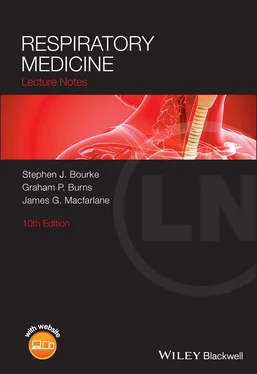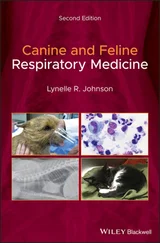Computed tomography scanning uses a technique of multiple projection with reconstruction of the image from X‐ray detectors by a computer so that structures can be displayed in cross‐section. A number of different techniques can be used depending on the area of interest. CT scanning is particularly useful in providing a detailed cross‐sectional image of mediastinal disease, which is often difficult to assess on plain chest X‐ray. Fig. 4.10shows the principal mediastinal structures with horizontal lines indicating the levels of the CT sections illustrated diagrammatically in Fig. 4.11. CT scanning is a key investigation in the staging of lung cancer (see Chapter 12) and detecting and determining the extent of bronchiectasis (see Chapter 8).
High‐resolution CT scans are much more sensitive than plain X‐ray in assessing the lung parenchyma and can provide a detailed image of emphysema (see Chapter 11) and interstitial lung disease. A ‘ground glass’ appearance on a high‐resolution CT scan of a patient with interstitial lung disease is relatively non‐specific whereas a ‘reticular honeycomb pattern’ indicates advanced fibrosis. CT scanners have the capacity to perform very rapid spiral images and this imaging technique combined with injection of radiocontrast material into a peripheral vein yields the CT pulmonary angiogram (CTPA) which can be used to identify emboli in central pulmonary arteries in thromboembolic disease (see Chapter 15).
Positron emission tomography
Positron emission tomography (PET) scanning is critical in the diagnosis and staging of lung cancer. It is based on the concept that neoplastic cells have greater metabolic activity and a higher uptake of glucose than normal cells. 18F‐fluoro‐2‐deoxyglucose (FDG) is a glucose analogue that is preferentially taken up by neoplastic cells after intravenous injection and then emits positrons. In lung cancer staging, PET scanning is used to detect metastases and to determine involvement of lymph nodes in patients being considered for radical treatment such as surgical resection or high‐dose radiotherapy (see Chapter 12). It is also particularly useful in the differential diagnosis of an indeterminate solitary pulmonary nodule. Often such a nodule is small and not amenable to biopsy. Calcification or lack of growth of the lesion over time suggest that the nodule is benign (e.g. hamartoma, healed tuberculous granuloma). If the patient is a smoker at high risk of cancer and otherwise fit, it may be advisable to proceed directly to surgical resection of such a lesion without preoperative histological confirmation. Active accumulation of FDG in the lesion on PET scanning suggests malignancy. False‐negative findings can occur in tumours <1 cm and false‐positive uptake can occur in inflammatory conditions such as tuberculosis, sarcoidosis, histoplasmosis and coccidioidomycosis.
 KEY POINTS
KEY POINTS
The chest X‐ray has a key role in the investigation of lung disease. It should be studied in a systematic way and interpreted in the context of all clinical information.
CT is more sensitive than the chest X‐ray and is crucial in the staging of lung cancer, in assessing interstitial lung disease and in diagnosing pulmonary emboli.
Ultrasonography is useful in assessing pleural effusions and is used to guide placement of a chest tube when draining a pleural effusion.
PET is helpful in diagnosing and staging lung cancer.
 FURTHER READING
FURTHER READING
1 Hansell DM. Thoracic imaging. In: Gibson GJ, Geddes DM, Costabel U, Sterk PJ, Corrin B, eds. Respiratory Medicine. Edinburgh: Elsevier Science, 2003: 316–51.
2 Lynch DA, Godwin JD, Safrin S, et al. High‐resolution computed tomography in idiopathic pulmonary fibrosis. Am J Respir Crit Care Med 2005; 172: 488– 93.
3 MacMahon H, Austin JHM, Gamsu G, et al. Guidelines for the management of small pulmonary nodules on CT scans: a statement from the Fleischner Society. Radiology 2005; 237: 395–400.
4 Remy‐Jardin M, Ghaye B, Remy J. Spiral computed tomography angiography of pulmonary embolism. Eur Respir Monograph 2004; 27: 124–43.
5 Vansteenkiste JF. Imaging in lung cancer: position emission tomography scan. Eur Respir J 2002; 19 (suppl 35): 49–60.
6 Verschakelen JA, DeWever W, Bogaert J, Stroobants S. Imaging: staging of lung cancer. Eur Respir Monograph 2004; 30: 214–44.
Multiple choice questions
1 4.1 Cavitation is a characteristic feature of: a hamartomafibrotic lung diseaseHaemophilus influenzae pneumoniaStaphylococcus aureus pneumoniasmall cell lung cancer
2 4.2 An air bronchogram in an area of consolidation suggests: bronchial obstruction due to carcinomainfarction secondary to a pulmonary embolisman arteriovenous malformationpneumoniasarcoidosis
3 4.3 Avid uptake of uptake of 18 F‐fluoro‐2‐deoxyglucose on PET‐CT scan is: diagnostic of lung cancerconsistent with TBof no diagnostic value unless the lesion is >1 cmsuggestive of a neurofibroma if posterior within the lungpresumed to be due to a rheumatoid nodule in a patient with rheumatoid arthritis
4 4.4 A 65‐year‐old smoker presents with cough, purulent sputum and left chest pain. Chest X‐ray shows features of left lower lobe collapse. The most likely diagnosis is: pneumoniapneumonia with a parapneumonic effusioninfective exacerbation of COPDbronchial carcinomaan inhaled foreign body in the left lower lobe bronchus
5 4.5 A 60‐year‐old woman is found to have a posterior lower mediastinal mass on chest X‐ray and CT. The most likely cause is a: Morgagni diaphragmatic herniathymomaoesophageal cystpericardial cystneurofibroma
6 4.6 On a chest X‐ray the outline of the right hemidiaphragm is indistinct. The X‐ray is otherwise unremarkable. The most likely explanation is a: collapse of the right lower lobevariation of normal, which can be disregardedconsolidation in the right middle loberight lower lobe consolidationmediastinal shift to the left
7 4.7 A chest X‐ray reveals a total ‘white‐out’ of the left hemithorax, with a normally aerated lung on the right. Possible explanations include: congenital absence of the left lungcomplete consolidation of the left lunga left‐sided pleural effusioncomplete collapse of the left lungmassive pulmonary embolism
8 4.8 In the X‐ray described in 4.7, the most useful feature in distinguishing between the two MOST likely explantions for the ‘white‐out’ would be: visibility of the left hemidiaphragmpresence of the silhouette sign on the left mediastinumposition of the tracheaheight of the right hemidiaphragmpresence of vascular markings on the right
9 4.9 If a pulmonary embolism is suspected the most useful radiological investigation is: lateral CXRPA X‐rayhigh‐resolution CT scanCT pulmonary angiogramPET scan
10 4.10 On the cross‐sectional image from a CT scan at a level just above the arch of the aorta: the oesophagus is not visiblethe oesophagus is just anterior to the brachiocephalic veinthe trachea is the most anterior mediastinal structurethe left lung is not visiblethe aorta is not visible
1 4.1 DCavitation is the presence of an area of radiolucency within a mass lesion. It is a feature of squamous carcinoma, tuberculosis, lung abscess, pulmonary infarcts, granulomatosis with polyangiitis (formerly known as Wegener granulomatosis) and some pneumonias (e.g. Staphylococcus aureus, Klebsiella pneumoniae).
Читать дальше

 KEY POINTS
KEY POINTS FURTHER READING
FURTHER READING









